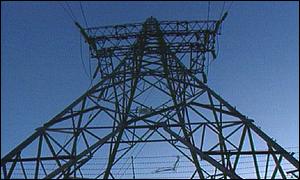

The National Radiological Protection Board's investigation has reviewed recent evidence including a study of 3,000 children in the US, Europe and New Zealand, published late last year, which suggested that pylons could double the risk of childhood leukaemia.
The NRPB's study, chaired by respected scientist Sir Richard Doll, is likely to conclude on Tuesday that the increased danger is slight as the ordinary risk is only one in 20,000 children.
It will insist that evidence is weak but will call for further detailed research to explain "anomalous" studies.
If this is correct, it would represent a shift by the NRPB, which last year interpreted the biggest-ever study of childhood cancer and electromagnetic fields as evidence against a link.
More than 23,000 homes in the UK are situated near power lines and it has previously been suggested by campaigners that the electromagnetic field surrounding the cables can trigger leukaemia.
'Buffer zone'
Opponents are calling for a mandatory 50m "buffer zone" each side of the lines.
In the US, legislation prevents new homes being built near power lines.
But some opponents say that "hissing" cables, known as the corona effect, can extend the risk several hundred metres from power lines.
Some UK parents have engaged lawyers over the issue but studies have mainly been inconclusive.
A study by Bristol University scientists in 1999 identified a "causal" link between pylons and leukaemia.
But a number of other studies, including one involving Canadian children, have failed to prove a link and the Electricity Association has denied a connection.
Professor Colin Blakemore, an expert in electromagnetic fields from Oxford University, told the BBC that the risk from power lines only accounted for approximately 20% of the homes where electromagnetic fields were high.
He said that the extra risk from powerlines amounted to one additional case of childhood leukaemia every two years in the UK.
"The most recent study concluded there was a very small elevation of risk among the group of children exposed to very high levels of magnetic fields."
However, Alistair Phillips, from the pressure group Powerwatch, said: "The risk is significant.
"At least people will now know what it is and can measure the levels in their own homes."
Professor Denis Henshaw, from Bristol, whose has carried out research into how electromagnetic fields might be able to affect health said that the evidence was now strong.
He said: "Our research and also other international research shows a possible mechanism as to how this can actually occur.
"The implications are obviously enormous, and to be fair, the scientific data has been conflicting but I think we are in a situation now where I think the studies are all pointing in the same direction.
"You can't get away from the fact that the balance of the studies are all pointing to the ill health effects of living under high voltage power lines in adults and children."
Campaigner Maureen Asbury said that she would continue to press for more precautions against electromagnetic fields.
She said: "We are pleased that the problem has been recognised - but we have to continue with our campaign." In a statement the Electricity Association said today: "The considerable body of evidence that has been accumulated over the last two decades clearly suggests that magnetic fields do not cause cancer or any other disease.
"If it is indeed the guidance of the NRPB that this is no longer the case we would like the Board to clarify what needs to be done as an industry."